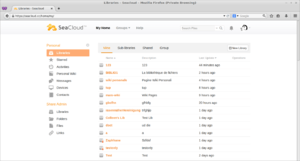Seafile
 | |
|
Seafile web client | |
| Developer(s) | Seafile Ltd. |
|---|---|
| Stable release | 6.0.5 (17 October 2016) [±][1] |
| Development status | Active |
| Written in | C, Python |
| Operating system | Cross-platform |
| Type |
Cloud storage Data synchronization |
| Licence | AGPLv3 (Community Edition) |
| Website |
seafile |
Seafile is a file-hosting software system. Files are stored on a central server and can be synchronized with personal computers and mobile devices through apps. Files on the Seafile server can also be accessed directly via the server's web interface. Seafile's functionality is similar to other popular file hosting services such as Dropbox and Google Drive. The primary difference between Seafile and Dropbox/Google Drive is that Seafile is a self-hosted file sharing solution for private cloud applications. In private clouds, storage space and client connection limits are determined exclusively by the users' own infrastructure and settings rather than the terms and conditions of a cloud service provider. Additionally, organizations, whose data privacy policies bar them from using public cloud services, can draw on Seafile to build a file sharing system of their own.
History
In 2009, Daniel Pan and other former students of Tsinghua University, Bejing embarked on a project aiming at building a peer to peer file sharing software, hence a system that does not rely on a centralized server. Seafile was the name chosen for their software project. The development team decided in 2010 to abandon this initial goal and refocussed on building a file syncing software with a more traditional client-server architecture - the architecture also used by Dropbox and other file hosting service providers.
In 2012, Daniel Pan, Jonathan Xu and other key developers of the project established Seafile Ltd. with the objective to develop and distribute the file hosting software.[2]
At the beginning of 2015, the distribution company Seafile GmbH was founded by Silja and Alexander Jackson to promote Seafile in Germany. Seafile Ltd., which did not take an equity stake in Seafile GmbH, granted usage rights for the Seafile brand and provided funding in the form of an interest free loan to the new company. The partnership was abruptly terminated in July 2016 due to disagreements between the two companies over, among other things, product development and intellectual property rights.[3][4]
Editions and versions
Seafile has two editions: a free community edition and a professional edition with additional features for enterprise environments.[5]
The community edition is released under the terms of the GNU Affero General Public License v3. The professional edition is released under a proprietary license.
Most Seafile installations – community as well as enterprise – are private cloud installations and service a clearly defined user group, i.e., the members of an organisation. There are also some public file hosting services based on Seafile.
Features
The feature set of the community and professional edition vary. Both editions share these features:[6]
- Multi-platform file synchronisation
- Public link sharing (upload and download)
- Client-side encryption
- Per-folder access control
- Version control
- AD/LDAP authentication
The additional features of the professional edition include:
- File locking
- Full text search
- MS Office document preview and office web app integration
- Two-factor authentication
- Activity logging
- Distributed storage
- Antivirus integration
Desktop clients are available for personal computers running on Windows, macOS, and Linux. Mobile clients are available for iOS, Windows Phone 8 and Android. Files can also be viewed, downloaded from and uploaded to the Seafile Server without the client via Seafile's web interface.
Seafile offers a choice of MySQL/MariaDB or SQLite for database and supports file system or distributed storage as data storage.[5]
Disputes
Seafile Ltd and Seafile GmbH
In July 2016 a dispute came to light between Seafile Ltd. (the original company, from China) and Seafile GmbH (a German company established from JacksonIT by Silja Jackson and Alexander Jackson in 2015).
Seafile Ltd. had funded Seafile GmbH to be a European partner. They then agreed to merge the main operations and license the cloud provision to a new company, but an agreement could not be reached on the number of shares to be allocated.[3]
Seafile Ltd. alleges that Seafile GmbH and its predecessors had attempted to register its trademark in the USA and had taken steps to present itself in place of Seafile Ltd. Seafile Ltd. also alleges that Seafile GmbH had abused the sourcecode and were committing copyright infringements.
Seafile GmbH stated it would fork based upon the most recent professional version and continue developing the file sharing software independently under the brand name Seafile, for which the company claims it hold the intellectual property rights in Europe and North America.[4] Seafile GmbH has not released a new Seafile server version since the announcement.
PayPal
In June 2016 Seafile GmbH had its payment services from PayPal removed. PayPal had accused Seafile of facilitating the illegal sharing of files and demanded that they monitor file transfers and provide statistical information to PayPal, which Seafile refused to do. Some days later PayPal reverted its decision and apologised to Seafile, but Seafile said they would drop PayPal in favour of other payment options.[7]
See also
- Comparison of file hosting services
- Comparison of file synchronization software
- Comparison of online backup services
References
- ↑ "SeafilePub – Seacloud". Retrieved 21 Oct 2016.
- ↑ Swapnil Bhartiya (2015-02-06). "Exclusive: Seafile Founder Daniel Pan Talks About His Open Source Cloud Software". Linux.com. Retrieved 2016-09-21.
- 1 2 "Statement about Stopping Cooperation with Seafile GmbH". Seafile Official Blog. 2016-07-22. Retrieved 2016-10-14.
- 1 2 "Zur Zukunft von Seafile | About the future of Seafile". Seafile Forum. Retrieved 2016-07-24.
- 1 2 Swapnil Bhartiya (May 2015). "Sea Treasure". Linux Magazine. Retrieved 2016-09-21.
- ↑ Jack Wallen (2016-07-11). "How to install the Seafile file and sync system on Ubuntu". TechRepublic. Retrieved 2016-09-21.
- ↑ David Meyer (2016-06-22). "PayPal Restores Account of Dropbox Rival After File-Monitoring Row". Fortune (magazine). Retrieved 2016-09-21.
